A concrete floor is the best option for a garage. The material is very strong, durable, resistant to moisture, oils, gasoline. However, in the garage, the load on it is large. Over time, the floor cracks, becomes uneven. It is easy to repair it.
The reasons for the appearance and the main types of base defects
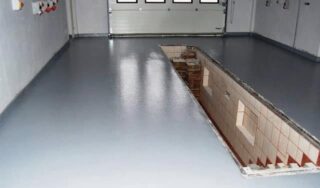
The concrete floor is durable, but the garage is not a place where a lot of attention is paid to caring for floors and walls. Over time, cracks, chips, peeling, and potholes appear on the flooring. Defects spoil the appearance of the concrete base and significantly affect its performance.
The reasons are divided into mechanical, operational and emerging as a result of chemical exposure.
- Potholes are the result of shock loads. They also appear under prolonged pressure of a large mass.
- Cracks are the result of improper action or uneven internal pressure. The more the actual load exceeds the calculated one, the stronger is the cracking. If the base was poured based on a passenger car, and a minibus is placed in the garage, deformation is inevitable. It is almost impossible to prevent the appearance of cracks, they just need to be repaired.
- Peeling of the top layer is the result of poor-quality drying of the concrete screed or floor finishing until the concrete is fully set. For the same reasons, bloating occurs.
- Dusting is the generation of fine fine dust. Most often it appears when there is an excess of cement in the initial solution.
- Deformation - in this case, the floor level in the center of the room becomes lower, and the edges seem to rise. The most common cause is insufficient reinforcement thickness.
- Light spots and streaks are efflorescence. The result of a violation of the humidity regime. Often caused by the peculiarities of the local soil - highly carbonate, for example.
- Destruction of the top layer - in unheated garages, the concrete floor is excessively cooled. In this case, the moisture accumulated in the upper layer of concrete freezes, expands and breaks the material.
Leveling the floor in the garage begins with determining the cause of the deformation. If this is a consequence of improper use, it is quite simple to eliminate them, as well as to eliminate the defect itself. If the concrete collapses due to a violation of the laying technology or manufacturing, it is easier to replace the flooring with a new one.
Required tools
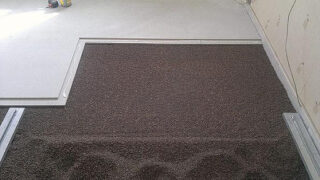
A variety of tools may be required to level floors. Most often we are talking about pouring a concrete screed, for which you need:
- rule and building level;
- spatula and trowel;
- perforated corners - they are used as beacons;
- a bucket for making a solution;
- construction mixer or electric drill with attachment.
If the base defects are small - chips, height differences are not more than 5 mm - they are leveled by grinding. This requires a sander.
Floor leveling materials
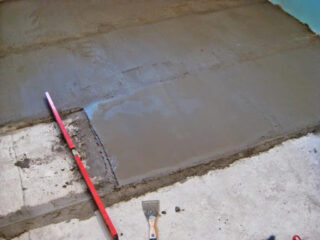
Do-it-yourself leveling of the concrete floor in the garage is performed in several ways. The technology depends on the nature of the material used and the degree of damage. If the potholes are large, and the chips and bulges have a large area, the floor must be leveled thoroughly. For this, coarse mixtures are used, like a cement-sand screed.In this case, the floor level rises by 2–8 cm.
If the irregularities are small, use plastic finishing mixtures that change the height of the flooring by 1–2 cm.
When it comes to individual chips or cracks, only the damaged areas are repaired.
Cement-sand screed
Concrete, dry mortar, and self-leveling floor are used as material for the leveling screed. For a garage, the optimum is a cement-sand mixture. This option is cheap, affordable, easy to prepare. The base turns out to be strong and durable.
The composition is purchased in a store or made independently from cement of the M500 brand and pure river sand mixed with cement in a ratio of 1: 3.
The step-by-step instructions for aligning are extremely simple. The base is cleaned, deep potholes are first filled with rubble and poured with concrete or the same mortar. Treat twice with a primer. Then it is poured with a cement-sand mixture, the screed is leveled according to the installed beacons.
The concrete acquires its final strength not earlier than after 3 weeks. At this time, you should periodically moisten the surface and cover the floor with a film.
Ready self-leveling mortar
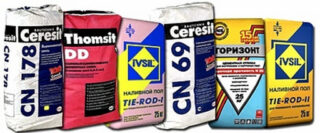
This is the name of semi-liquid building mixtures. Unlike a denser concrete mass, such a solution is not leveled, the composition spreads on its own, filling all cracks and irregularities, and forms an even smooth surface.
To level the damaged floor in the garage, use the following bulk mixtures:
- Epoxy - are highly resistant to chemically aggressive substances, including oil and gasoline. Withstand high mechanical stress. Minus: high price and long drying time.
- Methyl methacrylate - dry very quickly. The surface is durable, does not collect dust and does not peel off. Disadvantage: Difficulty in filling and toxicity: when working, you need to use a respirator, goggles and a protective suit.
- Cement-acrylic - such a floor is resistant to mechanical stress, it perfectly tolerates severe cold. The surface is rough, so it does not slip. The mixture is quite expensive.
In order for the floor to self-level with small defects, glue is added to the cement compositions. Both tile glue and PVA are added. Their use increases the plasticity of the mixture. This technique is used when preparing a screed under the flooring with tiles, boards.
Polyurethane compounds are not used in the garage, as they are unstable to mechanical stress.
Defect elimination technology
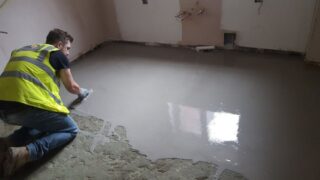
If the floor defects are not so great or are observed only in a limited space, local repairs are carried out. The work depends on the nature of the damage.
- Bumps and bulges are formed when the material dries and shrinks unevenly. Removing them is quite difficult. A small bulge can be knocked down with a hammer or chisel. If the bump is large, use a milling machine. If the bulge appears as a result of the bending of the reinforcement, the latter is cut off with a grinder.
- Cracks are much easier to repair. The indentations are widened with a chisel and hammer to give uniformity to the edges. If the crack is deep, it is reinforced by inserting metal rods. Then fill the prepared gap with water to precisely remove dust and dirt, and leave to dry completely. The crack is poured with a screed based on cement grade not lower than M400.
- Pits and potholes are repaired in a similar manner. It is recommended to remove the top layer of concrete in such an area. Then the recess is cleaned and covered with fine crushed stone. Fill the pothole with cement mortar. You can use epoxy concrete: it is more expensive, but hardens faster and is more durable.
If minor damage extends over the entire floor surface, local repairs are indispensable.
Curing
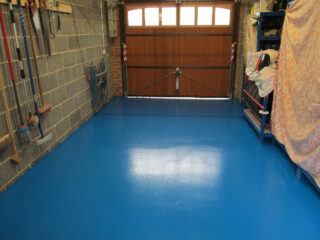
It is necessary to take care of the concrete so that it lasts longer.
- While the screed dries, it is periodically moistened with water, covered with plastic wrap so that the moisture does not evaporate too quickly.
- If the garage floor is exposed to heavy loads, the top layer should be reinforced. The easiest way to do this is iron. To do this, dry cement is rubbed into the surface with the addition of sifted quartz sand with particles of 0.2 mm in diameter, steel fiber, slaked lime with cement.
- To prevent dusting, the concrete floor is painted with a special paint for concrete.
- The surface must be periodically cleaned of debris, dust, dirt and oil stains.
Concrete floors are strong, durable and resistant. However, over time, defects appear on them. They are easy to get rid of using various methods.








